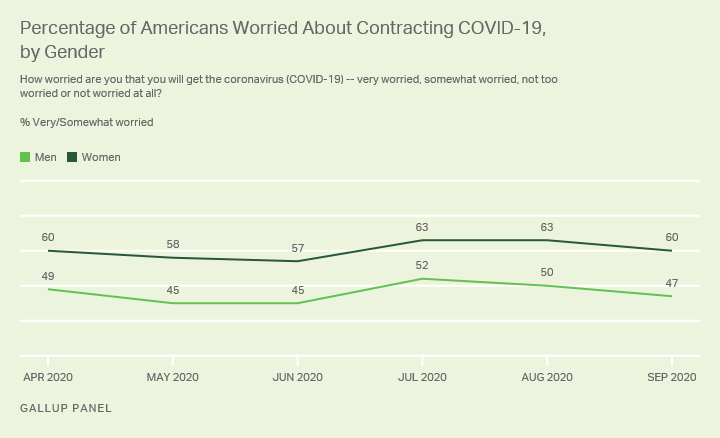Data collected via the Gallup Panel as part of its COVID-19 tracking poll reveal that throughout the pandemic, women have expressed more concern than men about contracting the virus. They also have shown a greater propensity to take protective measures against infection. Partisan differences have been paramount in U.S. adults' attitudes and behaviors related to COVID-19; however, the observed gender differences are greater than what we might expect on the basis of partisanship alone.
Our recently published article in a special issue of the political science journal Politics & Gender delves into these findings. Here, we offer some illustrative examples of the gender dynamic, using the most recent data available from the Gallup Panel. More detailed information and analyses can be found in the Gender & Politics article, "Double Whammy: Why the Underrepresentation of Women Among Workplace and Political Decision-Makers Matters in Pandemic Times."
Men, Women and COVID-19 Concern
First and foremost, throughout the pandemic, women have consistently been more concerned than men about catching COVID-19.

Line graph. Monthly trend from April 2020 to September 2020 in percentages of men and women who are worried about getting COVID-19. Trend shows a consistent gap of 11 to 13 percentage points. Most recently 60% of men in September and 47% of women are worried.
This attitude manifests itself in personal behaviors: In trends since June, women have been more likely than men to report having worn a mask at some point in the past seven days.

Line graph. Weekly trend since June in percentage of men and women who report wearing a mask in past seven days when outside the home. The gender gap has narrowed from roughly 10 points in June to four points in September as mask wearing has increased.
The gender difference in mask usage has been narrowing a bit in recent weeks, in a manner roughly consistent with an increase in mask wearing by Republicans. Regardless, there remains a statistically significant gender gap across time.
Gender differences in mask usage are also evident on the basis of self-reports of "always" wearing a mask in either indoor or outdoor situations when social distancing is not always possible. While Gallup finds much greater compliance with this recommendation among both genders for indoor settings, there are significant male-female gaps with respect to both indoor and outdoor settings.
| Men | Women | Gender gap | ||||||||||||||||||||||||||||||||||||||||||||||||||||||||||||||||||||||||||||||||||||||||||||||||||
|---|---|---|---|---|---|---|---|---|---|---|---|---|---|---|---|---|---|---|---|---|---|---|---|---|---|---|---|---|---|---|---|---|---|---|---|---|---|---|---|---|---|---|---|---|---|---|---|---|---|---|---|---|---|---|---|---|---|---|---|---|---|---|---|---|---|---|---|---|---|---|---|---|---|---|---|---|---|---|---|---|---|---|---|---|---|---|---|---|---|---|---|---|---|---|---|---|---|---|---|---|
| % | % | pct. pts. | ||||||||||||||||||||||||||||||||||||||||||||||||||||||||||||||||||||||||||||||||||||||||||||||||||
| Always wear mask when can't maintain social distancing: | ||||||||||||||||||||||||||||||||||||||||||||||||||||||||||||||||||||||||||||||||||||||||||||||||||||
| In indoor settings | 64 | 79 | +15 | |||||||||||||||||||||||||||||||||||||||||||||||||||||||||||||||||||||||||||||||||||||||||||||||||
| In outdoor settings | 23 | 30 | +7 | |||||||||||||||||||||||||||||||||||||||||||||||||||||||||||||||||||||||||||||||||||||||||||||||||
| Gallup Panel, Aug. 2-Sept. 27, 2020 | ||||||||||||||||||||||||||||||||||||||||||||||||||||||||||||||||||||||||||||||||||||||||||||||||||||
Men, Women and Social Distancing
There are similarly strong gender differences in Americans' self-reports of the extent to which they follow social distancing guidelines. Women (47%) are far more likely than men (35%) to say they always practice social distancing. Men (14%) are also a bit more likely than women (8%) to say they rarely or never practice it.
| Men | Women | Gender gap | |||||||||||||||||||||||||||||||||||||||||||||||||||||||||||||||||||||||||||||||||||||||||||||||||
|---|---|---|---|---|---|---|---|---|---|---|---|---|---|---|---|---|---|---|---|---|---|---|---|---|---|---|---|---|---|---|---|---|---|---|---|---|---|---|---|---|---|---|---|---|---|---|---|---|---|---|---|---|---|---|---|---|---|---|---|---|---|---|---|---|---|---|---|---|---|---|---|---|---|---|---|---|---|---|---|---|---|---|---|---|---|---|---|---|---|---|---|---|---|---|---|---|---|---|---|
| % | % | pct. pts. | |||||||||||||||||||||||||||||||||||||||||||||||||||||||||||||||||||||||||||||||||||||||||||||||||
| Always | 35 | 47 | +12 | ||||||||||||||||||||||||||||||||||||||||||||||||||||||||||||||||||||||||||||||||||||||||||||||||
| Very often | 34 | 32 | -2 | ||||||||||||||||||||||||||||||||||||||||||||||||||||||||||||||||||||||||||||||||||||||||||||||||
| Sometimes | 17 | 13 | -4 | ||||||||||||||||||||||||||||||||||||||||||||||||||||||||||||||||||||||||||||||||||||||||||||||||
| Rarely | 7 | 4 | -3 | ||||||||||||||||||||||||||||||||||||||||||||||||||||||||||||||||||||||||||||||||||||||||||||||||
| Never | 7 | 4 | -3 | ||||||||||||||||||||||||||||||||||||||||||||||||||||||||||||||||||||||||||||||||||||||||||||||||
| Gallup Panel, Aug. 2-Sept. 27, 2020 | |||||||||||||||||||||||||||||||||||||||||||||||||||||||||||||||||||||||||||||||||||||||||||||||||||
Gender, Partisanship and the Pandemic
With a persistent partisan gender gap in American politics, such that men are more likely than women to identify as Republicans, it is important to isolate whether gender differences pertaining to COVID-19 merely reflect differences in partisan preferences or whether there is a more fundamental difference between men and women on this measure.
Looking at the last two months of data, it is clear that differences between men and women are related to partisanship, but they also transcend it.
The following table shows that Democratic men and Democratic women tend to be relatively similar in their COVID-19-related attitudes and behaviors. It is also the case that the average Democratic man is more cautious with respect to COVID-19 than the average Republican woman.
But there are still clear gender differences that go beyond party. Strong gender differences are observed among Republicans (and independents, not shown here), such that men tend to be less concerned about and less likely to take measures to prevent COVID-19 transmission than women within their same party.
| Democratic men | Democratic women | Republican men | Republican women | ||||||||||||||||||||||||||||||||||||||||||||||||||||||||||||||||||||||||||||||||||||||||||||||||
|---|---|---|---|---|---|---|---|---|---|---|---|---|---|---|---|---|---|---|---|---|---|---|---|---|---|---|---|---|---|---|---|---|---|---|---|---|---|---|---|---|---|---|---|---|---|---|---|---|---|---|---|---|---|---|---|---|---|---|---|---|---|---|---|---|---|---|---|---|---|---|---|---|---|---|---|---|---|---|---|---|---|---|---|---|---|---|---|---|---|---|---|---|---|---|---|---|---|---|---|
| % | % | % | % | ||||||||||||||||||||||||||||||||||||||||||||||||||||||||||||||||||||||||||||||||||||||||||||||||
| Worried about getting the coronavirus | 77 | 80 | 20 | 29 | |||||||||||||||||||||||||||||||||||||||||||||||||||||||||||||||||||||||||||||||||||||||||||||||
| Concerned about exposure at place of work^^ | 57 | 62 | 23 | 39 | |||||||||||||||||||||||||||||||||||||||||||||||||||||||||||||||||||||||||||||||||||||||||||||||
| Always practicing social distancing | 54 | 57 | 19 | 29 | |||||||||||||||||||||||||||||||||||||||||||||||||||||||||||||||||||||||||||||||||||||||||||||||
| Avoiding going to public places | 70 | 73 | 31 | 38 | |||||||||||||||||||||||||||||||||||||||||||||||||||||||||||||||||||||||||||||||||||||||||||||||
| Avoiding small gatherings (friends/family) | 63 | 64 | 27 | 30 | |||||||||||||||||||||||||||||||||||||||||||||||||||||||||||||||||||||||||||||||||||||||||||||||
| Avoiding events with large crowds | 89 | 89 | 48 | 60 | |||||||||||||||||||||||||||||||||||||||||||||||||||||||||||||||||||||||||||||||||||||||||||||||
| Always wear mask in indoor settings when can't socially distance |
90 | 93 | 40 | 56 | |||||||||||||||||||||||||||||||||||||||||||||||||||||||||||||||||||||||||||||||||||||||||||||||
| Always wear mask in outdoor settings when can't socially distance |
36 | 39 | 10 | 15 | |||||||||||||||||||||||||||||||||||||||||||||||||||||||||||||||||||||||||||||||||||||||||||||||
| Ready to return to normal activities right now |
5 | 3 | 64 | 54 | |||||||||||||||||||||||||||||||||||||||||||||||||||||||||||||||||||||||||||||||||||||||||||||||
| ^ Independents not shown; ^^ Based on adults employed full or part time | |||||||||||||||||||||||||||||||||||||||||||||||||||||||||||||||||||||||||||||||||||||||||||||||||||
| Gallup Panel, Aug. 2-Sept. 27, 2020 | |||||||||||||||||||||||||||||||||||||||||||||||||||||||||||||||||||||||||||||||||||||||||||||||||||
Multivariate analyses described in the journal article confirm that these gender effects exist even with controls.
Discussion
Gender differences with respect to the novel coronavirus pandemic are not surprising. During previous respiratory disease outbreaks around the world, researchers have shown that women are significantly more likely to take nonpharmaceutical measures like washing their hands frequently, wearing masks and avoiding public transportation in order to minimize their chances of contagion.
In the current U.S. context, however, this raises a particular question about whether sometimes-contradictory Republican positioning on the seriousness of COVID-19 and the need to take preventive measures such as business closures and mask mandates to inhibit its spread might also contribute to the widening of the partisan gender gap.
The journal article also extends the gender analysis into the workplace, showing that employed women are more concerned than employed men about catching COVID-19 and that this extends to women with workplace leadership roles. This may have significant implications for how well back-to-work policies represent women's sensibilities, and ultimately how well women adapt to the new workplace normal.




